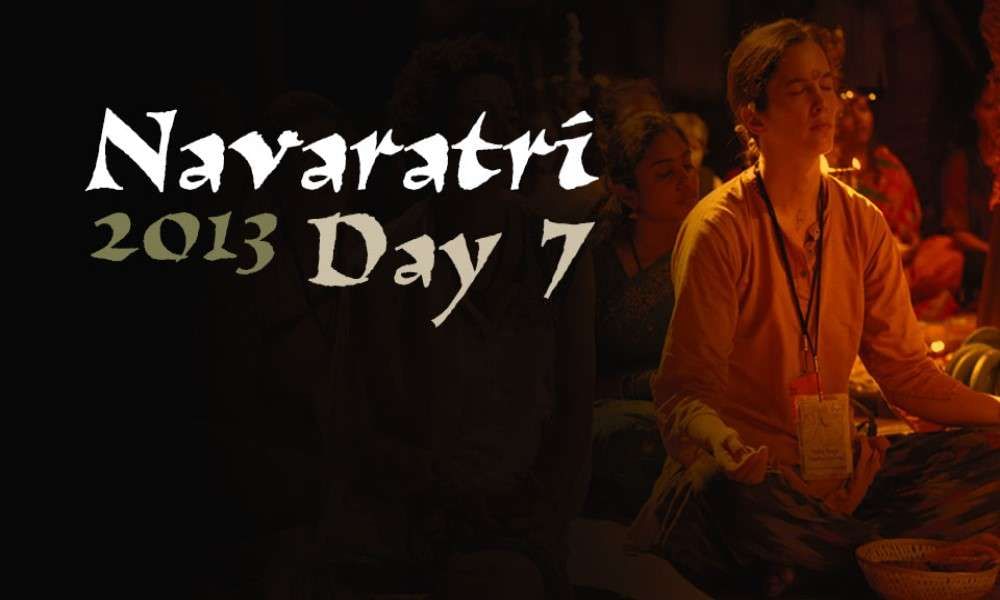Navratri Celebrations 2013 – Time to Refine
On the seventh day of Navratri, Sadhguru looks at the quality of sattva, and we explore the history of mehndi – the art of applying designs on one’s body – in India.

Sattva – Refining the Body
The seventh, eight and ninth days of Navratri are the time of Sarasvati and the quality of sattva. Today, Sadhguru speaks about this quality.
Sadhguru: There is no physical entity without all these three dimensions – sattva, rajas and tamas. Every atom has these three dimensions of vibrance, of energy, of a certain static nature. If these three elements are not there, you cannot hold anything together. It will break up. If it is just sattva, you won’t remain here for a moment – you will be gone. If it is just rajas, it’s not going to work. If it’s just tamas, you will be asleep all the time. So, these three qualities are present in everything. It is just a question of to what extent you mix these things.
Moving from tamasic nature to sattva means you are refining the physical body, the mental body, the emotional body and the energy body. If you refine this so much that it became very transparent, you cannot miss the source of creation which is within you. Right now, it is so opaque that you cannot see. The body has become like a wall blocking everything. Something so phenomenal – the source of creation – is sitting here but this damn wall can block it because it’s so opaque. It’s time to refine it. Otherwise you will only know the wall, you will not know who lives inside.
Subscribe
Mehndi

Hands of Grace, the handicrafts exposition has begun at the Isha Yoga Center, and will run till 13th October. Today, we feature a stall that has been drawing a lot of attention – the mehndi stall. The art of applying mehndi – intricate designs on one’s hands and feet using henna – goes back a few thousand years at least. The word mehndi comes from the Mendika plant (Egyptian Privet), whose leaves are crushed to produce the henna paste. Unlike tattoos, which are more or less permanent and require elaborate procedures to remove, mehndi is only applied to the top layers of the skin, which are naturally shed in the course of a few weeks, leaving the skin clean (and ready for the next application and design!).
Mehndi is generally applied using a plastic cone or a paint brush and traditionally, the process of applying the mehndi is as important as the finished design itself. Mehndi is an important part of the lead-up celebrations to Indian weddings, and signifies that the bride and groom seek green pastures, the color of henna when dry, and that their life together be rosy, the color of henna after it is washed off.
Sri Ranjani Santhanagopalan – Carnatic Vocals

Sri Ranjani Santhanagopalan, the daughter and disciple of Neyveli Santhanagopalan is one of the most promising artistes in the Carnatic music scene today. An A-Grade artist of All India Radio, she is the recipient of numerous awards, including the Best vocalist award from Music Academy, Chennai in 2012, Yuva Kala Bharati from Bharat Kalachar, M.S. Subbulakshmi award from Narada Gana Sabha, and M.L.Vasanthakumari award from Parthasarathy Swami Sabha. She is currently pursuing an M. Phil in Music. She will be accompanied by Ms. Aditi on the violin and Guru Ragavendra on the mridangam.
Sri Ranjani Santhanagopalan began her performance with a composition by Sri Koteeswara Iyer, Edayya Gathi – a song about Shambho Maheshwara – set to raga chalanata, a sampoorna raga with all the seven ragas in the linear scale. Next was a popular composition of Muthuswami Dikshitar set to raga nagagandhari. Next was a kriti of Muthuswami Dikshitar, Pallayamam Parvatisha, set to the rare and infrequently heard raga kannada, a derivative of the popular raga shankarabharanam. She was accompanied by Ms. Aditi on the violin and Guru Ragavendra on the mridangam. Next was a composition of Papanasam Sivan, set to raga mukhari, which is quite similar to raga bhairavi.
Join the webcast live at 5.30 PM IST (12 noon GMT) at http://isha.sadhguru.org/live/


